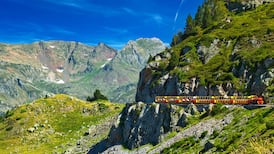|
Port to Maghera via Slievetooey, Co Donegal
Start: Port, 15km west of Maghera |
The deserted fishing village of Port, whose desolation began in famine times, provides a fascinating start to the walk. A tiny bay on a rock-bound coast could not have been an easy place to fish from and the location of the abandoned cottages well above the shoreline are a mute reminder of the great Atlantic swells that must surge into this little harbour during storms.
The dramatic spectacle of the coastline becomes apparent as you ascend the grassy flanks of Port Hill; 200m cliffs plunge to the ever-present Atlantic swell while, offshore, a succession of sea stacks stand sentinel at the entrance to each cove.
The largest of these inlets is at the mouth of the Glenlough Valley. There is an ideal viewing point on a flat headland which is reached after you cross the Glenlough River.
Great sheets of scree tumble down the face of the precipice to be rounded and smoothed by the eternal swash and backwash of the waves. The poet Dylan Thomas, who stayed in an old cottage at the head of the glen in the summer of 1935, likened the pebbles to “the souls of the dead Irish . . . and if you stand on the nearby hill and shout ‘I am dead’ they will answer back and I will force them to confess that they are sad, grey, lost, forgotten, dead and damned forever”. I don’t think he had much respect for us.
I headed off uphill again, skirting the rock outcrops and over to a most spectacular land form. A narrow indent cut into 300m high cliffs. The rock in this area is Quartzite, metamorphosed sandstone, formed by heat and pressure during tectonic movements.
These seismic events must have caused fault-lines to develop at this point which assisted wave action in creating this most impressive feature.
You have a choice at this point, either to continue along the coast or head upwards to bag Slievetooey (Sliabh Thuaidh, the northern mountain). This was my option. It is a steep pull at the start but once you attain the 400m contour line you are on a boggy plateau which circles around the combe containing Lough Adoochro.
Continue east over to Spot Height, at 472m, which overlooks Lough Croaghballaghdown and across to the main peak. You’ll have to drop down to a col which offers a great view down into the combe and then back up to the trigonometrical station at 511m. From here you look down on to the magnificent spread of Maghera Strand. The thickening heat haze had dissolved the mountainous periphery into dim outlines but on a clear day there must be a magnificent panorama.
I took the easy option for the descent which is to go south on to Slí Cholmcille and continue down the road on the side of a classic U-shaped valley to Maghera where Hugh Gavigan, who runs the car park, organised a taxi to return me to Port.










